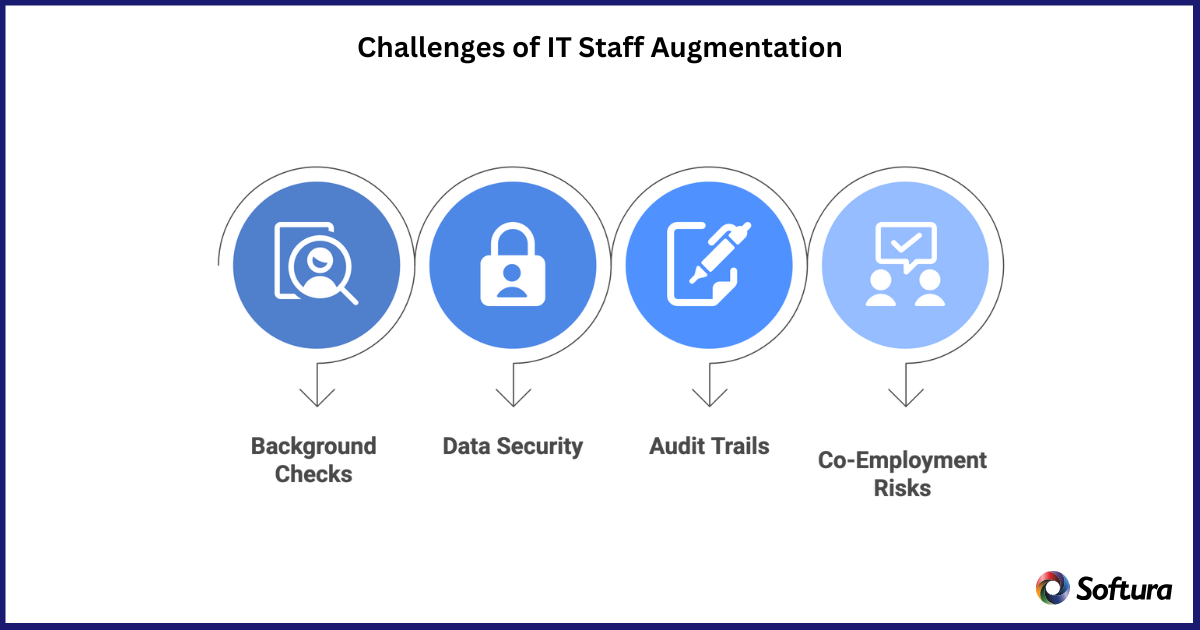"Our integration with the Google Nest smart thermostats through Aidoo Pro represents an unprecedented leap forward for our industry."
- Antonio Mediato, founder and CEO of Airzone.
Working in healthcare, finance, government, and other tightly regulated industries for years has taught me one important truth: these sectors do not adopt new delivery models unless every detail aligns with compliance, security, and operational integrity. IT Staff Augmentation is no exception. Leaders love the flexibility it brings, but they worry about oversight, data exposure, and regulatory risk.
However, when implemented thoughtfully, augmentation is not only safe—it often becomes the most effective way for regulated enterprises to scale development, accelerate modernization, and meet regulatory deadlines without overwhelming internal teams. I’ve seen CIOs and CTOs use augmented specialists to fill rare skill gaps, support cloud migrations, secure systems, and push long-delayed projects across the finish line.
This expanded guide unpacks the reasons for caution, the real challenges organizations face, and a clear roadmap to using augmentation confidently, securely, and in full alignment with regulatory expectations.
Industries such as healthcare, finance, and government operate inside rigid compliance frameworks that dictate how data must be handled, accessed, stored, and reported. These include:
When augmented specialists join your teams, they must follow every rule—exactly as your full-time employees do. That’s why many boards and compliance teams scrutinize augmentation more carefully than traditional hiring.
Regulators do not distinguish between your employees and your augmented staff. If an external developer mishandles sensitive data, introduces a vulnerability, or violates a compliance process, your organization—not the vendor—absorbs the impact.
This creates natural hesitation. Leaders want assurance that:
These concerns are valid, and any augmentation program must address them openly.
For decades, regulated industries have preferred fully managed service models because responsibility clearly sits with the vendor. Staff augmentation flips that model—you retain control and oversight.
That shift can feel uncomfortable. But with structure, governance, and clear boundaries, augmentation offers more flexibility without increasing risk. Many organizations use a hybrid model: internal oversight + augmented specialists + compliance-driven processes.
"Our integration with the Google Nest smart thermostats through Aidoo Pro represents an unprecedented leap forward for our industry."
- Antonio Mediato, founder and CEO of Airzone.

Augmented professionals must often pass the same onboarding controls as internal hires, including:
Not every vendor has the infrastructure to support these standards, making partner selection crucial.
External staff may need access to PHI, PII, financial records, or confidential government information. To stay compliant, organizations must enforce:
Any gap—no matter how small—can turn into a regulatory incident.
In regulated industries, every action must be traceable. Auditors expect to see:
Failing to document properly is treated the same as doing the wrong work. Augmented teams must adapt to detailed documentation expectations from day one.
Organizations sometimes unknowingly manage augmented staff like full-time employees, which may raise co-employment risks. To stay compliant:
This distinction protects both the client and the vendor.
"By analyzing the data from our connected lights, devices and systems, our goal is to create additional value for our customers through data-enabled services that unlock new capabilities and experiences."
- Harsh Chitale, leader of Philips Lighting’s Professional Business.
Regulated businesses should work with vendors who already understand their compliance burdens. The right partner will have:
This dramatically reduces onboarding friction.
Every augmented team member should understand:
Training eliminates ambiguity and reduces avoidable mistakes.
To reduce exposure:
This ensures augmented staff operate safely within a controlled environment.
Contracts should go beyond general NDAs. They must include:
These legal structures align expectations and reduce risk.
A strong governance approach includes:
This ensures augmented staff do not act independently without oversight.

Banks use augmentation to scale development teams for:
To remain compliant, teams enforce:
With the right structure, augmentation helps financial institutions meet regulatory deadlines and strengthen system resilience.
Healthcare providers augment teams to accelerate:
Success requires:
This allows hospitals to innovate while maintaining patient trust.
Government agencies use augmentation for:
These engagements require:
Augmentation helps agencies accelerate mission-critical programs despite strict hiring constraints.
Regulated sectors often need niche expertise that is difficult to recruit for, such as:
Augmentation provides access to these professionals without long hiring cycles.
When new regulations emerge or modernization becomes urgent, augmentation enables organizations to:
This flexibility is essential when facing regulatory audits, system migrations, or cybersecurity upgrades.
Experienced augmented specialists often bring best practices from other regulated industries. Pairing them with internal staff:
This creates long-term value beyond the engagement itself.
Compliance must be treated as an ongoing cycle. Organizations should perform:
These routines keep augmented work aligned with regulatory obligations.
Involving compliance teams early ensures:
This reduces friction and ensures smoother audit cycles.
When augmented staff roll off:
This avoids compliance gaps that can surface later.
IT Staff Augmentation is often misunderstood in regulated industries. Many leaders fear loss of control, compliance gaps, or operational risk. But with the right structure—experienced vendors, strong governance, strict access controls, detailed documentation, and compliance-driven processes—augmentation becomes a strategic advantage.
Regulated organizations that implement augmentation thoughtfully gain:
You don’t have to choose between compliance and agility. With the right approach, IT Staff Augmentation helps you achieve both—and positions your organization for secure, sustainable growth.
Build Secure, Compliant IT Teams Without Slowing Down
Strengthen your delivery capacity with pre-vetted, regulation-ready IT specialists who follow strict security, documentation, and governance standards.